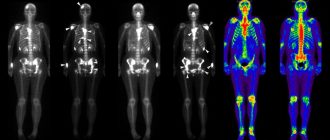A blood test for prostate cancer is one of the first methods for diagnosing oncology. Unfortunately, its accuracy does not allow a confident diagnosis, so it is a preliminary study before prescribing more complex procedures. After collection, the blood is examined for several parameters, the combined results of which allow one to suspect a malignant neoplasm and the degree of its development.
What blood tests are performed
When diagnosing prostate cancer, several tests are performed that involve drawing blood. All of them require fluid to be withdrawn from a vein.
The most important blood test for prostate cancer is the prostate-specific antigen test (commonly called PSA for short). This substance is produced directly by the prostate, so when it increases, its amount also increases. In addition, the prostate gland can enlarge not only with oncology, but also with BPH or prostatitis, so this method of research alone may not be enough. Additionally, a general and biochemical blood test . Cumulative positive indicators also do not provide sufficient accuracy for diagnosis, but become sufficient for other laboratory and instrumental studies.
What indicators indicate cancer?
With cancer, blood parameters change such as:
- prostate-specific antigen;
- hemoglobin level;
- red blood cell count;
- leukocyte count;
- erythrocyte sedimentation rate.
Prostate-specific antigen is analyzed using multiple parameters at once. It is important not only its quantity, but also the ratio of free PSA to bound, as well as its ratio to the size of the gland itself. A fairly important indicator is the increase in the level of prostate-specific antigen over time. But to be able to analyze this parameter, its level must be measured constantly, at least once a year.
If all parameters are positive when diagnosing oncology, the following examinations are prescribed:
- urine test for hemoglobin, leukocytes and UBS tumor marker.
- palpation of the prostate;
- Ultrasound, TRUS, CT or MRI;
- biopsy (the most accurate results are obtained when the procedure is performed in conjunction with MRI or CT, because targeted sampling of material is possible).
Preparation for the event
Blood counts can be distorted under the influence of various factors. To prevent this from happening and to ensure that the diagnostics show reliable results, a number of restrictions are prescribed before taking the material. The most important thing is to avoid eating 8-10 hours before donating blood. You should also refrain from drinking coffee, strong tea and alcoholic beverages. Also, 2-3 days before the analysis, it is necessary to refrain from sexual intercourse, because during the process of ejaculation, the amount of PSA is released and increases. For the same reason, 2 weeks before the analysis, prostate massage is stopped. It is also important to temporarily give up horseback riding or cycling. All medications taken should be discussed with your doctor; some of them can also distort the results of diagnostic tests.
Norm and deviations
General blood test indicators for prostate cancer:
- Reduced hemoglobin level.
- Decrease in the number of red blood cells.
- Increased level of leukocytes.
- The leukocyte sedimentation rate is more than 20 mm/hour.
Normal PSA levels in the blood change with age:
- At 40-50 years old, the PSA level is no more than 2.5 ng/ml.
- 50-60 years - 3.5 ng/ml.
- 60-70 years old - 4.5 ng/ml.
- Over 70 years old - 6.5 ng/ml.
- A reading of 6-8 ng/ml indicates the first stage of cancer.
- 10-20 ng/ml – for the second.
- 20-40 ng/ml – on the third.
- Over 40 ng/ml – on the fourth.
No less important is the ratio of free PSA to bound PSA:
- with 25% of the total amount of free PSA, the probability of developing an oncological process is about 8%;
- at 20% - 16%;
- at 15% - 20%;
- at 10% - 28%;
- up to 10% - 56%.
If prostate-specific antigen levels are measured annually, changes over time can be compared. A reading below 0.75 ng/ml per year is considered normal. Changing it also allows you to track the effectiveness of the treatment.



